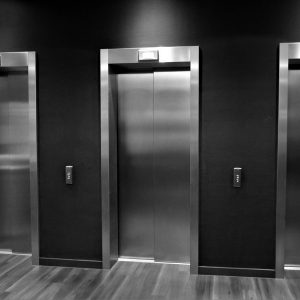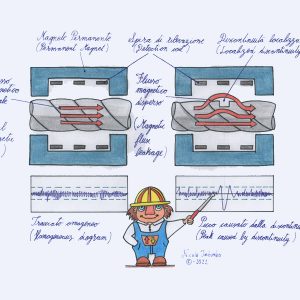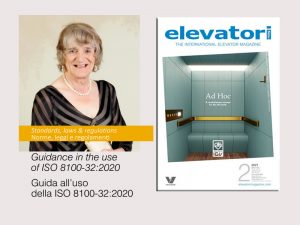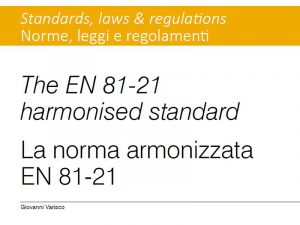Firefighter lifts and the operation in the event of a fire – Part 1
By Giovanni Varisco
Published on Elevatori Magazine Issue 1 Year 2019
With this article, we will bring to the fore the discussion of two harmonised European standards that are of fundamental importance for lifts in buildings with a fire risk. These are the EN 81-72 standard (Safety rules for the construction and installation of lifts – Special applications for passenger and freight lifts – firefighter lifts) and the EN 81-73 standard (Safety rules for the development and installation of lifts – Special applications for passenger and freight lifts – Behaviour of lifts in the event of fire.).
It is immediately evident that these harmonised standards are not to be applied to all lifts but instead to those lifiting installations that should be subject to compliance with important fire regulations and which must also consider the various national laws which are, however, different from Member State to Member State of the European Union.
We will also keep in mind the changes that have been made to the requirements of the harmonised standard EN 81-72 following the publication of the EN 81-20 and EN 81-50 standards and we will begin to focus on EN 81-72 on firefighter lifts (those used by firemen in their job).
Introducti on of the standard
In its introduction, the standard points out, as, in all other harmonised European standards, that agreements between the building manager and the lift installer must be stipulated in advance. With particular relation to its intended and environmental conditions, interface with fire prevention systems, fire prevention and smoke management, as well as materials (water, etc.) used to extinguish flames, to manage routine and emergency power supply, to commands in the car that must be made available to the Fire Brigade.
Field of application
It is always important, if not essential, to read the indications given by the standard about its field of application. The comment may appear excessive, but, it is always crucial to know when and why a harmonised technical standard can or must be applied.
In the case of the EN 81-72 standard, it is applied if the characteristics of the lift shafts and the rooms are such as to prevent the entry of smoke and fire into the lift shaft and the spaces/premises of the machinery. If the structure of the building is such as to limit the flow of water to the lift shaft and if the lifts are not to be used as routes or means of escape in the event of a fire. The EN 81-72 standard does not cover the installation of lifts in lift shafts that are not entirely closed nor does it cover significant changes to a lift.
Definitions
As in all other harmonised European standards, definitions are essential to learning the precise meaning of the terms used in the standard itself.
“Evacuation” means the ordered and organised movement of people moving from a dangerous situation to a safe area in the building.
“Fire” refers to a material whose combustion produces flames, heat and smoke.
The standard defines “Control system” as the behaviour of the lift to manage input and output signals to make the relevant devices operate in the appropriate and desired manner, By “fire compartment” we deem it as a physical subdivision of the building enclosed between walls, protection, doors and attics to limit the spread of fire and hot gases inside the premises.
The “firefighter lift” is a lift that has commands, protection and warnings that only allow it to be used by professionals to put out the fire (Fire Brigade).
The EN 81-72 standard defines “fire protection” as the necessary set of measures used to prevent the spread of fire by creating escape routes and determining the fire resistance of the structure and the materials that constitute it.
The standard defines a “firefighter lift switch”, as a switch placed at the fire service level (and optionally positioned in the lift car) that is used to start firefighting operations.
“Fire Service access level” means the level of the premises taken by the firefighters for the operations of extinguishing and the fighting of the fire. The definition of “safe area” refers to a protected and safe area for access to the lift and the exit from the lift.
This area must remain as such during firefighting operations while maintaining the necessary protection against fire and gas development.
“Building Management System (BMS)”, by the EN 81-72 standard, means a system capable of making intelligent decisions based on the information received.
The si gnificant hazards A paragraph of the EN 81-72 standard provides a list of the dangers that the standard has taken into consideration to define the protective measures to be made.
The hazards have been identified and treated following an appropriate risk assessment and have been divided into two tables referring respectively to the dangers related to the environment concerned and to the lift itself.
The dangers related to the environment concerned were regarded as:
• smoke and fire introduced into the lift shaft and the machinery spaces as well as in the safe areas;
• lift not usable during firefighting operations;
• firefighter intervention over 2 minutes;
• water flow occurred in the lift shaft;
• entrapment of people in a safe area due to lift failure;
• the collapse of the structure before the end of the fire-fighting operations;
• environment harmful to firefighters;
• insufficient or faulty positioning of the firefighting lifts.
The dangers related to the lift were taken into consideration as follows:
• general threats associated with the operation and use of lifts;
• risk imprisonment for people;
• firefighter intervention over 2 minutes;
• overlap and combination of different concurrent hazards;
• failure or incorrect operation of the lift;
• consequences of human error or human (predictable) behaviour;
• inadequate design of manual controls or defects in their placement and identification;
• inadequate marking;
• failure of the power supply system.
We will continue to discuss the harmonised standards EN 81-72 and EN 81-73 in the next issue of Elevatori magazine, beginning with the essential summary of the safety requirements
set by the standard about the lifts used in firefighting operations.




